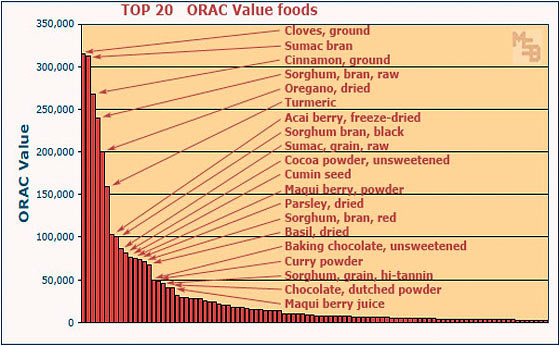ORAC Value List – Top 100 Highest Antioxidant Spices, Herbs, Products
(ORAC list below)
The ORAC value of the following spices-herbs-foods-berries are rated very high and are worth considering for your overall health and well-being.
ORAC is an abbreviation for Oxygen Radical Absorbance Capacity and was developed by the National Institutes of Health in Baltimore.
ORAC units measure antioxidant capacity of foods. Higher ORAC value units potential for better health.
(Consult your doctor for medical advice.)
It is widely believed that high antioxidant foods help greatly to lower the risks of cancer, degeneration, and disease.
The following list consists of high ORAC value food and spices. Consider making an effort to obtain and consume more of them in your normal diet.
Highest ORAC Value Product In The World?
First, be sure to read the notes below. Second, you’re probably looking for a list of high ORAC value foods – potentially good choices for augmenting your health.
Within the realm of common availability, Ground Cloves are VERY high in antioxidant on the ORAC value scale. Greater than 314,000 µmol TE/100g (see explanation below). Uses: baked sweets, meats, ham, sweet potatoes, baked beans, bbq & tomato sauces, pumpkin pie, gingerbread…
Acai Berry – Freeze Dried
The Acai Berry ORAC value is among the highest of the berries. It has more than 100,000 µmol TE/100g (see explanation below). A popular form of this native fruit from Brazil is freeze dried. 1 Tablespoon mixed in with a yogurt or a smoothie. Keep in refrigerator for maximum shelf life.
>> Organic ACAI Powder (Freeze-Dried)
(view on amzn)
Acai berry smoothie:
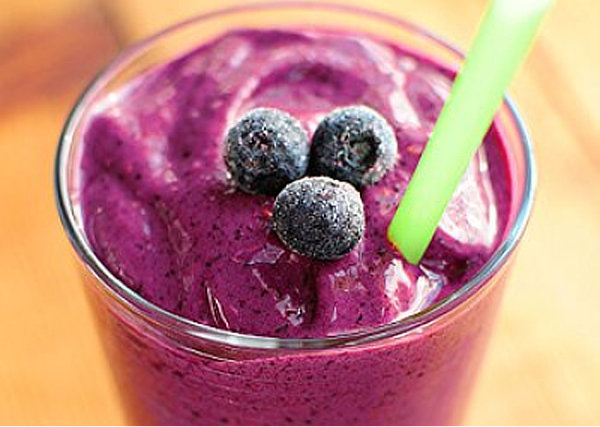
ORAC Score ( A Few Notes )
Note: The ORAC values in this list are normalized to 100 grams of weight (~ 3.5 ounces) because that’s how the original database of information was presented. The intent is to ‘normalize’ the various items to simply compare ‘raw value’, NOT ‘amount per serving’.
Note: This ORAC list does not factor or attempt to suggest the quantities that a person would normally eat in one serving (for example – who is going to eat 3.5 ounces of cloves in one serving??). I simply intend to point out which ‘foods’ are literally the highest in ORAC value (that I could find information about).
Note: The ORAC value of a given food will vary due to growing conditions, processing conditions, specific variety and others.
Note: Data sourced from the US Department of Agriculture during 2010. The USDA recommends an ORAC unit ingestion of about 3,000 to 5,000 units daily.
Note: ORAC values listed here are in units of µmol TE/100g (micromol Trolox Equivalent per 100 grams). Trolox equivalency is used as a benchmark for the antioxidant capacity.
Note: The list I’ve put together here is not all-inclusive
Note: Source: USDA’s Nutrient Data Laboratory (NDL)
Update: Sometime during 2012, the USDA apparently removed their ORAC listings.
ORAC Value Top 20 list
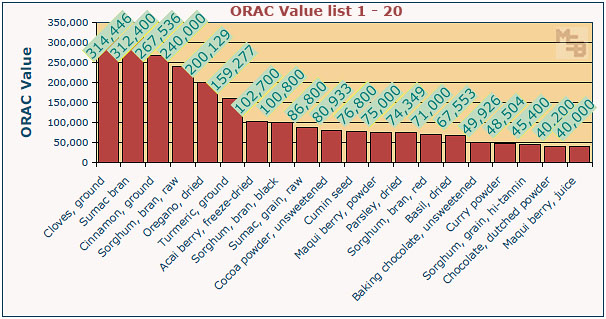
[ Read: STUDY FINDS 2 Tbsp Cocoa a Day Helps Keeps Memory Loss Away ]
[ Read: Mayan Cacao Powder: A Super Food ]
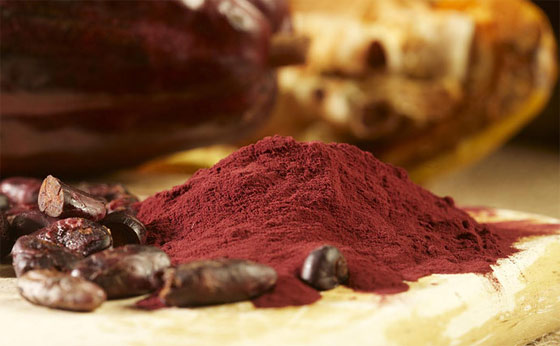
>> Certified Organic Cacao Powder
(view on amzn)
ORAC Value list 21 – 40
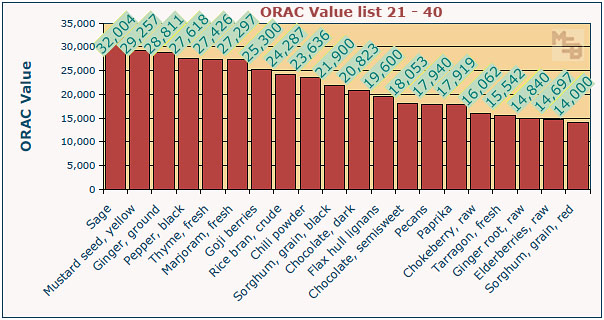
ORAC Value list 41 – 60
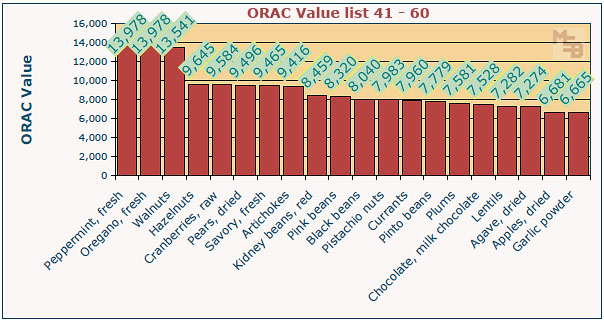
[ Read: 10 Powerful Spices! ]
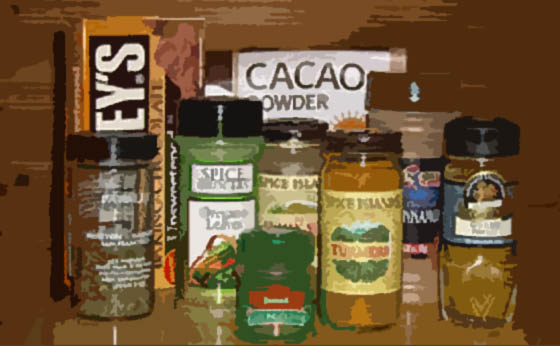
ORAC Value list 61 – 80
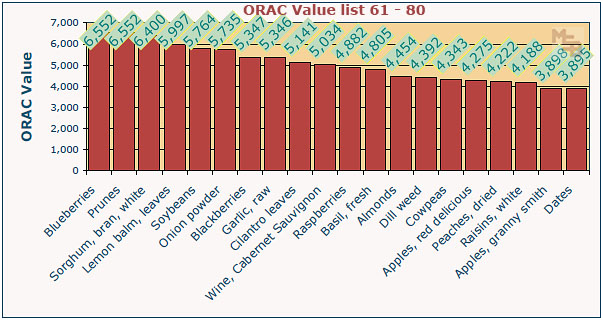
[ Read: Turmeric SUPER SPICE – Home Remedies ]
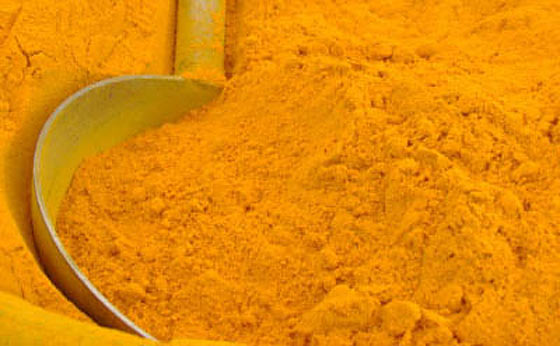
ORAC Value list 81 – 100
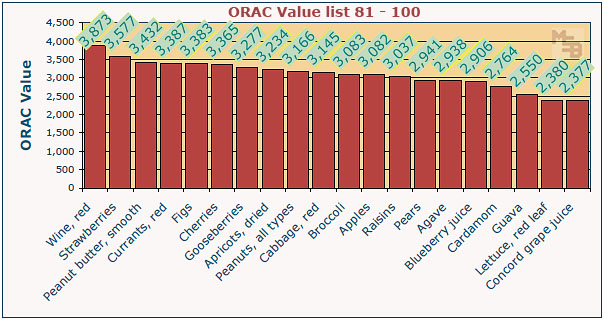
ORAC Value List, Top 100
| 1 | Cloves, ground | 314,446 |
| 2 | Sumac bran | 312,400 |
| 3 | Cinnamon, ground | 267,536 |
| 4 | Sorghum, bran, raw | 240,000 |
| 5 | Oregano, dried | 200,129 |
| 6 | Turmeric, ground | 159,277 |
| 7 | Acai berry, freeze-dried | 102,700 |
| 8 | Sorghum, bran, black | 100,800 |
| 9 | Sumac, grain, raw | 86,800 |
| 10 | Cocoa powder, unsweetened | 80,933 |
| 11 | Cumin seed | 76,800 |
| 12 | Maqui berry, powder | 75,000 |
| 13 | Parsley, dried | 74,349 |
| 14 | Sorghum, bran, red | 71,000 |
| 15 | Basil, dried | 67,553 |
| 16 | Baking chocolate, unsweetened | 49,926 |
| 17 | Curry powder | 48,504 |
| 18 | Sorghum, grain, hi-tannin | 45,400 |
| 19 | Chocolate, dutched powder | 40,200 |
| 20 | Maqui berry, juice | 40,000 |
| 21 | Sage | 32,004 |
| 22 | Mustard seed, yellow | 29,257 |
| 23 | Ginger, ground | 28,811 |
| 24 | Pepper, black | 27,618 |
| 25 | Thyme, fresh | 27,426 |
| 26 | Marjoram, fresh | 27,297 |
| 27 | Goji berries | 25,300 |
| 28 | Rice bran, crude | 24,287 |
| 29 | Chili powder | 23,636 |
| 30 | Sorghum, grain, black | 21,900 |
| 31 | Chocolate, dark | 20,823 |
| 32 | Flax hull lignans | 19,600 |
| 33 | Chocolate, semisweet | 18,053 |
| 34 | Pecans | 17,940 |
| 35 | Paprika | 17,919 |
| 36 | Chokeberry, raw | 16,062 |
| 37 | Tarragon, fresh | 15,542 |
| 38 | Ginger root, raw | 14,840 |
| 39 | Elderberries, raw | 14,697 |
| 40 | Sorghum, grain, red | 14,000 |
| 41 | Peppermint, fresh | 13,978 |
| 42 | Oregano, fresh | 13,978 |
| 43 | Walnuts | 13,541 |
| 44 | Hazelnuts | 9,645 |
| 45 | Cranberries, raw | 9,584 |
| 46 | Pears, dried | 9,496 |
| 47 | Savory, fresh | 9,465 |
| 48 | Artichokes | 9,416 |
| 49 | Kidney beans, red | 8,459 |
| 50 | Pink beans | 8,320 |
| 51 | Black beans | 8,040 |
| 52 | Pistachio nuts | 7,983 |
| 53 | Currants | 7,960 |
| 54 | Pinto beans | 7,779 |
| 55 | Plums | 7,581 |
| 56 | Chocolate, milk chocolate | 7,528 |
| 57 | Lentils | 7,282 |
| 58 | Agave, dried | 7,274 |
| 59 | Apples, dried | 6,681 |
| 60 | Garlic powder | 6,665 |
| 61 | Blueberries | 6,552 |
| 62 | Prunes | 6,552 |
| 63 | Sorghum, bran, white | 6,400 |
| 64 | Lemon balm, leaves | 5,997 |
| 65 | Soybeans | 5,764 |
| 66 | Onion powder | 5,735 |
| 67 | Blackberries | 5,347 |
| 68 | Garlic, raw | 5,346 |
| 69 | Cilantro leaves | 5,141 |
| 70 | Wine, Cabernet Sauvignon | 5,034 |
| 71 | Raspberries | 4,882 |
| 72 | Basil, fresh | 4,805 |
| 73 | Almonds | 4,454 |
| 74 | Dill weed | 4,392 |
| 75 | Cowpeas | 4,343 |
| 76 | Apples, red delicious | 4,275 |
| 77 | Peaches, dried | 4,222 |
| 78 | Raisins, white | 4,188 |
| 79 | Apples, granny smith | 3,898 |
| 80 | Dates | 3,895 |
| 81 | Wine, red | 3,873 |
| 82 | Strawberries | 3,577 |
| 83 | Peanut butter, smooth | 3,432 |
| 84 | Currants, red | 3,387 |
| 85 | Figs | 3,383 |
| 86 | Cherries | 3,365 |
| 87 | Gooseberries | 3,277 |
| 88 | Apricots, dried | 3,234 |
| 89 | Peanuts, all types | 3,166 |
| 90 | Cabbage, red | 3,145 |
| 91 | Broccoli | 3,083 |
| 92 | Apples | 3,082 |
| 93 | Raisins | 3,037 |
| 94 | Pears | 2,941 |
| 95 | Agave | 2,938 |
| 96 | Blueberry juice | 2,906 |
| 97 | Cardamom | 2,764 |
| 98 | Guava | 2,550 |
| 99 | Lettuce, red leaf | 2,380 |
| 100 | Concord grape juice | 2,377 |
Again, this ORAC score list does not factor or attempt to suggest the practical quantities that a person would normally consume in one serving.
Rather, it simply is an attempt to point out the ORAC value for each ‘food’ (at least those that I could find information about).
Feel free to add to the list via your comments below:
Continue Reding: APPLE CIDER VINEGAR – Benefits Your Health

